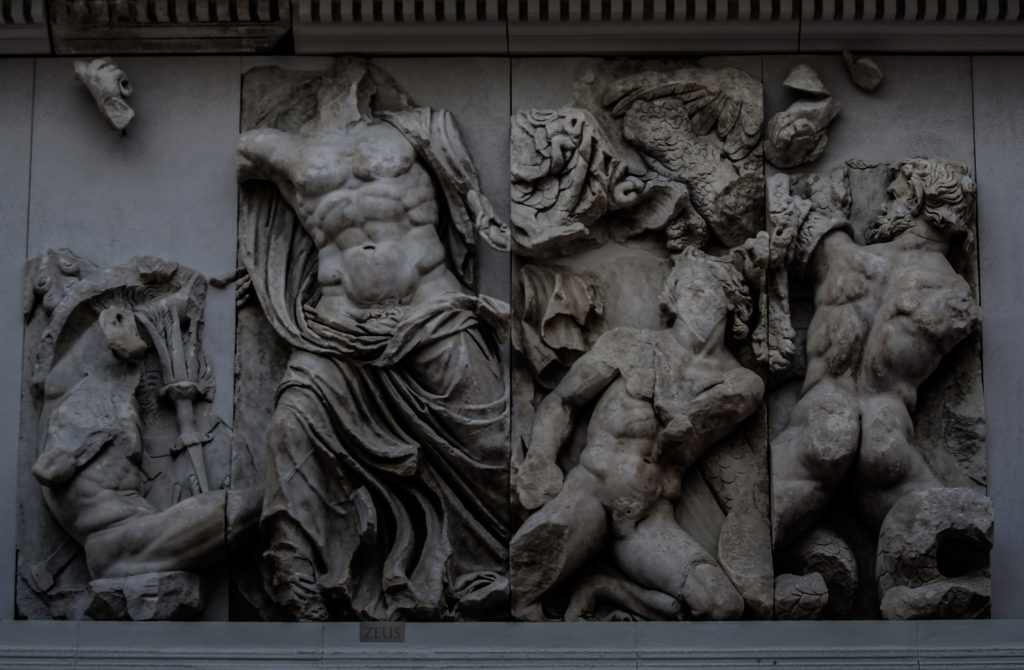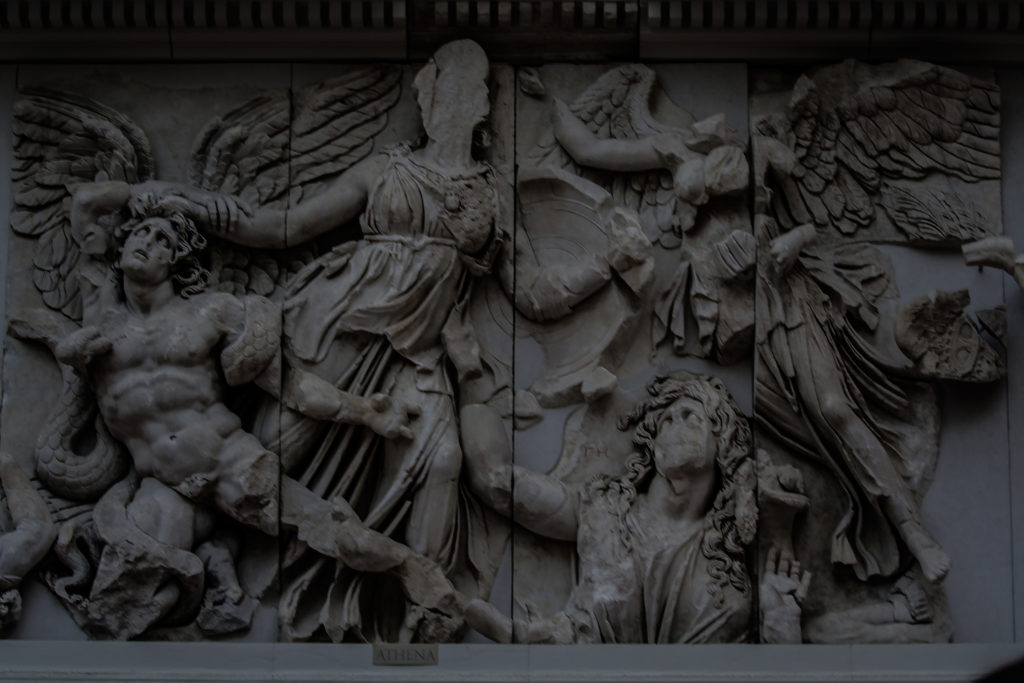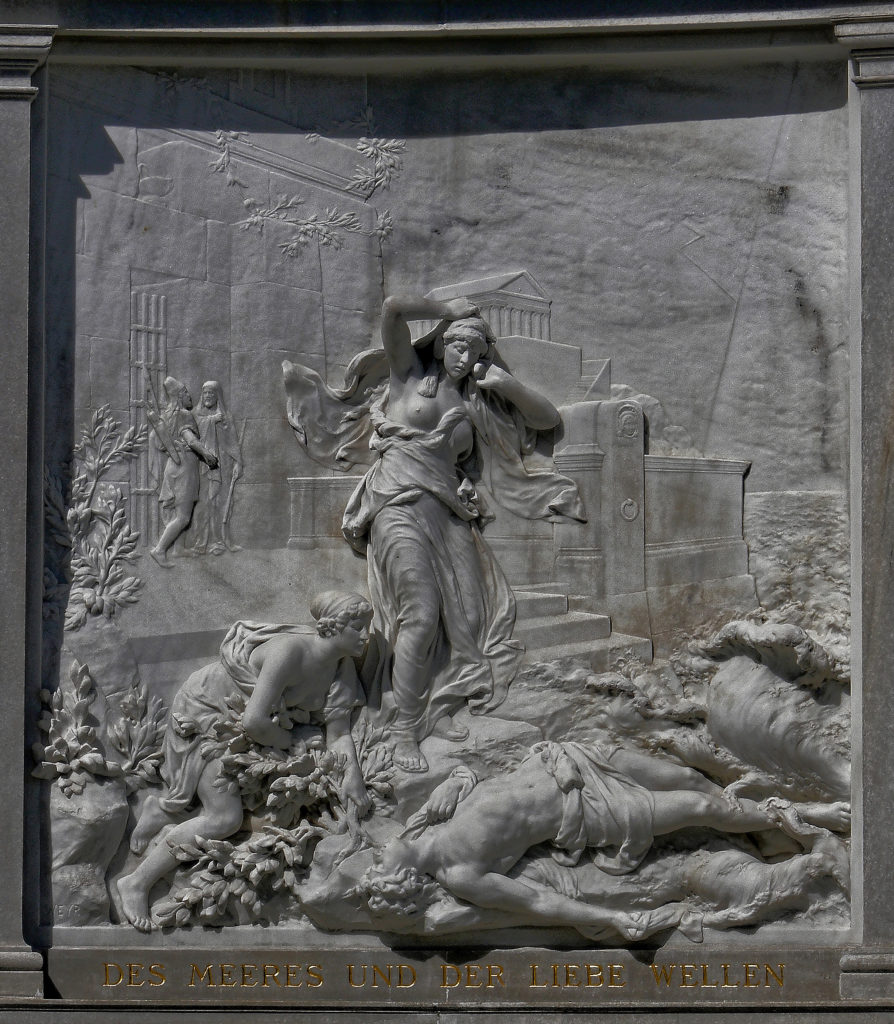FIGURE RELIEF SCULPTURE COURSE

Frederich Wilhelm Eugen Doel – Minerva handing Pegasus over to Bellerophon, marble relief in Gotha, Thüringen
Contact: 301 633 2858, or 443 764 5364 by cell phone call, or text message, or contact: [email protected] to arrange a visit, or to enroll in a class or open group. Message Board below seems to have issues. Calendar is general information on classes available, days and times vary.
This course will be taught in two parts, each part consisting of 9 four-hour sessions (day), or three-hour sessions (evening). The same pose, and intended Life Model, or Antique, or Modern Sculpture Plaster Figure, or Anatomical Model will be utilized several class sessions, to more extended projects within the two parts 9 meeting each time frame. There will be a half-hour to one-hour (day), or one-half hour (night) review for the class after the life model each session, making a total of four hours – (day), or three hours -(night). Additional optional limited workshop time is available without life model, to work on the relief from Antique Sculpture Plaster Figure / Portrait Bust, or Anatomical Model. Limited optional workshop time is available each week depending on the class, and particular week. Limited optional workshop time is included in the class price, but attendance is not required. Rescheduling the limited optional workshop is not possible after the timeslot is coordinated with the students for the semester. Students will focus on bone landmarks and major muscle groups while working to capture the action of the pose and characteristics of the model. Overall forms will be blocked in through observation of shapes, rhythms and interconnecting commensurate planes, leading to a simplified yet integrated relief sculpture, defining sculptural content, and sketch composition. This course will establish how to develop a relief sculpture from a shape orientation method, as opposed to copying shadows, and light, which is not a dependable factor in representing content.
Cost for the course:
$ 1200.00 for first 9 – 4-hour daytime sessions.
Or
$ 1200.00 for first 9 – 3-hour evening sessions.
$ 1200.00 for second 9 – 4-hour daytime sessions.
Or
$ 1200.00 for second 9 – 3-hour evening sessions.
The eye takes in information that the mind develops to realize subject and form. We only see what we think we know and have learned to perceive. Through a series of exercises, students will begin the process of seeing dimensionally within a context of related shapes. Because of this study, students will initiate the necessary skills to construct aesthetic form. Sculpture study will comprise figure relief sculpture in plasteline (non-drying clay).
COURSE OBJECTIVES:
To develop perception of patterned shape
To develop the ability to take angles and proportions
To understand glyptek shape as it describes form
To develop turning rythems to create an effective composition
To develop visual scale from life to the sculpture
To understand commensurate planes
To learn basic anatomy
Participants are responsible for their own materials. Easel, (An alternative to using an easel is to hold a board at the portion on one’s legs where they meet the torso, while seated in a chair. The board will then need to be taller than the paper in order to draw at the lower paper portion, away from one’s torso, and legs. A thinner thickness Baltic Birch plywood (Baltic Birch hardwood plywood comes in a number of metric thickness size choice) is a good alternative to a heavy fir plywood if the board is going to sit on one’s legs for hours. Also the Baltic Birch plywood less likely to warp over time compared to standard plywood, especially if the board is polyurethaned as well. Paper size should fit well within the outer border of the drawing board, but allow metal clips to hold the outer paper inch or two. Vine Charcoal (Willow Charcoal) thin straight sticks, Condensed / compressed Charcoal square sticks in a case (Charkole) for applying a tone to a good grade single sheet charcoal white paper, kneaded eraser, a lightweight mall stick – straight – for sighting angles, a thin leather artist natural chamois, sandpaper stack on a rectangular flat stick – at art stores, etc… is some of the drawing material used as supplied by participants of the class. Additional drawing material supplies for preparatory relief drawing, sculpture tools, sculpture relief armatures, and plasteline are supplied by the participants joining the class course. Countersunk screws are required on the underside of the figure armature plywood – as well as a smooth surface on the side of the A/C, or A/B exterior plywood board placed on the wheeled sculpture stands. Wheeled Stands are available for the relief sculpture armature to sit on top of while working the sculpture, but for the relief sculpture, an easel of enough strength to support the clay weight, supplied by each student while attending the course might be preferable. Relief sculpture armatures will be built in the first and possibly second meeting as a free benefit to those enrolled, and who have paid for the relief sculpture class – prior to the 13 sessions as paid classes. Another option would be students constructing their own relief armature ahead of the class course, on an approved armature design. There are several options on how to build a relief armature depending on the budget allowed by each student. Plywood pieces need to be cut to specific dimensions prior to arriving to build, put together the armature. There are commercial lumber yards with wood shops that can cut the plywood pieces. Information, / supply list, / instructions on a well-designed, and constructed portrait, figure, or relief sculpture armature is available by request from Brad Parker. Plastelene should be used as the clay material, not water clay since water clay produces an enormous amount of dust, and debris – so no water clay is allowed for use in the studio here. Chavant NSP, Soft, Red Brown – Non-Sulfur Plastelene is the better product of the various plastelenes. Please request a supply list.
___________________________________________________
Students of painting and drawing, as well as those of sculpture, will benefit from these courses. Through the study of anatomy, running rhythms, natural geometric shape type, shape projection (seeing three-dimensionally from a single point of view), commensurate planes, balance, symmetry and asymmetry, the students will come to better understand the actual shapes of the bust or figure and to perceive the interrelationships which cause the figure or portrait to seem capable of function and movement. The instructor will point out specific shape types in the model and demonstrate how every large shape is reflected in each smaller part of the head or figure. Structural anatomy and the balance of weight and mass will be studied in depth. An understanding of the large masses as a base for smaller details will be strongly emphasized and, subsequently, the bust or figure will seem more natural and clearly ordered. Shadows will be used as a tool to reveal shape instead of hiding it. As a result of the course, students will become less likely to do work which appears oversimplified, disjointed or appear cartoon-like. Individual styles may be achieved later by choice rather than by mistake.
Students will also have visual access to a unique and extensive collection. There are Anatomical Models, and European Female, Male Skeletons available for reference, some of which were produced in Germany from the earlier 20th century: dissections cast from life into hand painted plaster – a series of four levels of the head / neck – from surface to deeper level structures, and a plaster hand painted anatomical torso; anatomical models of various scale, plasters from N.Y.C. full body in sections of dissection from life, as well as European Antique Sculpture Plaster Casts, and Anatomical scale Figure Plasters. Classes of Sculpture and Drawing will define what is sculpture, and what is drawing, theory, and practical application from a traditional art perspective, with content as influenced from Greek Classical, Greek Hellenistic, and the traditions developed in Renaissance, Baroque, Neo-Classical, and Neo-Hellenistic art.
___________________________________________________________________________
Sculpture Armature will be built in a class previous to the first weeks class with the model. A complete supply list is available for the Sculpture Armature and Sculpture Tools for enrolled students. Classes are limited to 10 students.
__________________________________________________________________________
Parking is free, there is plenty of space available for the model and students to park on the Square, as well as additional parking behind the townhouse in a private parking area.
___________________________________________________________________________
More advanced classes available.
Private Sculpture Studio, Drawing & Sculpture Classes, By Appointment – Open Drawing & Sculpture Group Sessions, Commissioned Portrait Bust Sculpture, Fountain Sculpture, Figure Sculpture, & Relief Sculpture Compositions. Private Gallery of exhibited sculpture, by appointment only.

Great Frieze of the Pergamon Altar, 180-159 BC. East frieze. Zeus fights against two young Giants but also against their leader Porphyrion (right), ‘Gigantomachy’, the struggle between the gods and the giants, Pergamon Museum, Berlin

Pergamon Altarpiece. Built by order of Eumenes II Soter. 164-156 B.C. by artists of the school of Pergamon. Marble and Limestone. East frieze. Gigantomachy. Struggle between gods and giants. Athena taking the young Alcyoneus by the hair while his mother, Gaia leaves the ground due to the death of her son. Next, the winged Nike. Pergamon Museum, Berlin, Germany
[contact-form][contact-field label=’Name’ type=’name’ required=’1’/][contact-field label=’Email’ type=’email’ required=’1’/][contact-field label=’Website’ type=’url’/][contact-field label=’Comment’ type=’textarea’ required=’1’/][contact-field label=’Telephone Number’ type=’text’/][contact-field label=’Name of the Art Class Course%26#x002c; or Open Group you are interested in attending%26#x002c; or requesting information on. ‘ type=’text’/][contact-field label=’City%26#x002c; State%26#x002c; Country’ type=’text’/][contact-field label=’The day of the week%26#x002c; the hours available%26#x002c; time frame you would be interested in an ongoing Class Course Session%26#x002c; or Open Group Session to participate in. There is the possibility of an additional Class%26#x002c; or Open Group Sessions depending on the response of enrollment%26#x002c; or participation interest. The main Art Classes page heading has what are active Class Course Sessions%26#x002c; and Open Groups. ‘ type=’text’/][contact-field label=’Potential Student%26#x002c; Artist participant in an Open Group%26#x002c; or you are a potential Life Model?’ type=’text’/][contact-field label=’New Field’ type=’text’/][/contact-form]
